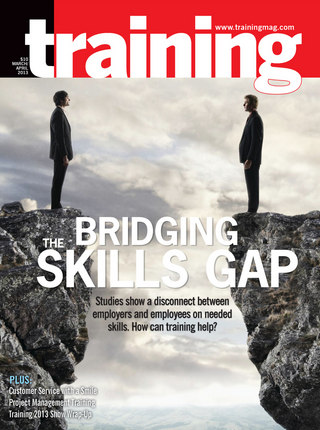Home March / April 2013
Talent Tips: Make Your People Matter in Meetings
By Roy Saunderson, Chief Learning Officer, Rideau’s Recognition Management Institute
There is a classic cliché definition that meetings are where minutes are kept and hours are lost. However, someone I know recently challenged that perspective by suggesting the idea that every meeting should be a revelatory experience.
Best Practices: Can Trust Be Taught?
By Neal Goodman, Ph.D., President, Global Dynamics, Inc.
Afundamental impediment in human interactions is the lack of trust. According to Stephen M.R. Covey, author of bestseller “The Speed of Trust,” training programs to promote trust enhance performance and profitability.
Training magazine Events: Donメt Get Caught Looking
By Jason Bickle, Manager, Instructional Design & Development, Experlogix, Inc.
Soapbox: You Should Be in Pictures
By Diane De Re, President, 321 FastDraw Inc.
Since the dawn of time, mankind has used images to communicate. From the El Castillo cave in Cantabria, Spain, with artwork of bison, horses, aurochs, and deer painted on the cave walls by our ancestors nearly 40,000 years ago, to ancient Egypt as far back as 3200 B.C. where hieroglyphs were used as a writing system, it is clear that the use of artwork is one of our most basic and powerful forms of communication, seemingly hardwired into our genetics.
Soapbox: Quality vs. Quantity
By D’Anna Flowers, IT Training Manager, Accretive Health, Inc.
No More Bored Meetings
By Marc Hequet
Rob Bellmar sprinted for home, glancing over his shoulder to check for the throw. That’s when he stepped on the bat in the base path and blew out his right quadriceps leg muscle.
He learned something, though. About meetings.
The softball injury last June meant that Bellmar, senior vice president at InterCall, had to phone in for a meeting a few days later, rather than attend in person.
Last Word: Embrace Social Media Carefully
By Peter Post, Director, The Emily Post Institute
Are companies really embracing social media? It appears so. The average midsize or large company (1,000 employees or more) has 178 “social media assets,” according to the Business2Community Website. That means that, on average, 178 individuals are tweeting, blogging, or posting on behalf of their organizations on company social media outlets.
How-To: Integrate Customer Service and Applications Training
By Kent Sipes, Senior Consultant, CedarCrestone
In customer service offices around the world, employees interact with customers, then intently study their computer screens, then interact with customers again. Often, the switch from customer to screen and back is awkward, and most customer service professionals are more comfortable dealing with people than with computers. There’s often a tendency to do all the “computer” work, then all the “people” work.


